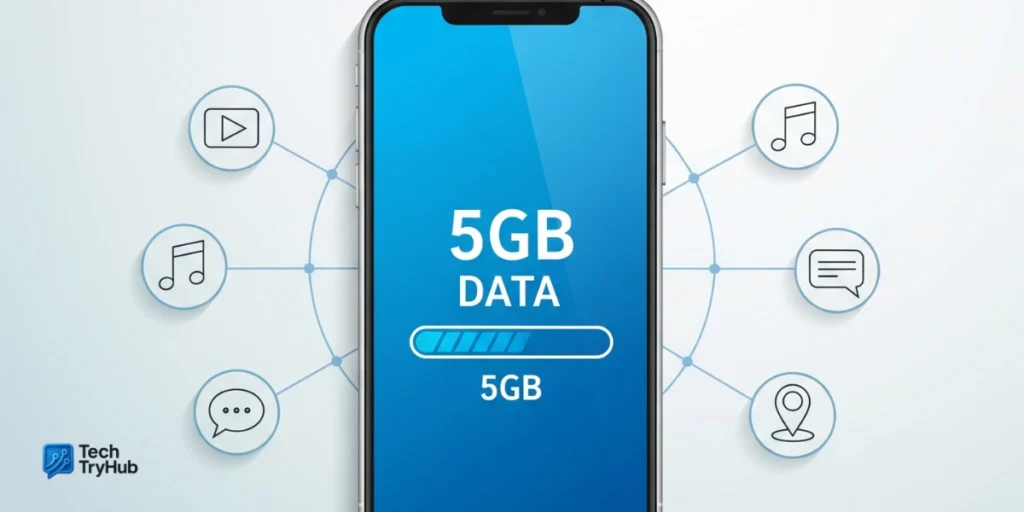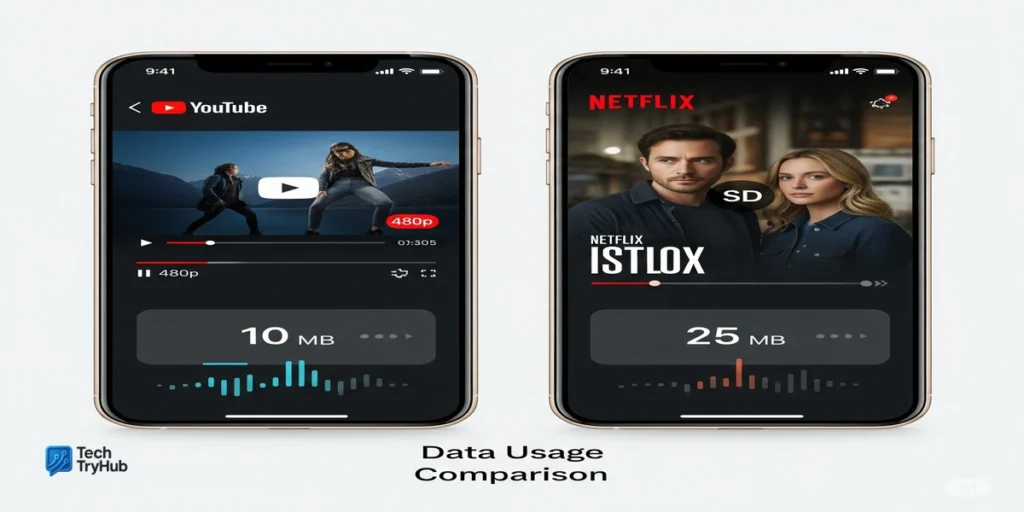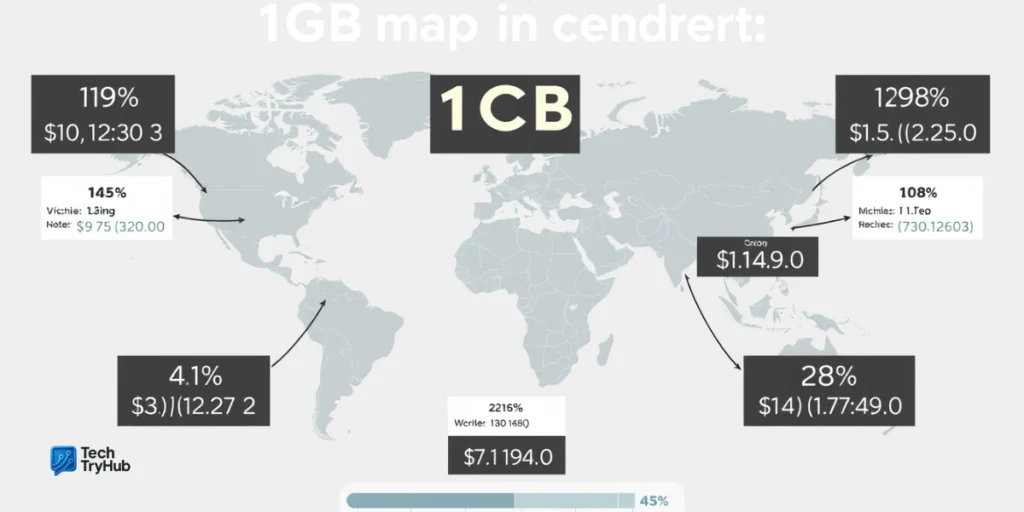Introduction: “Is 5GB tiny or just right?”
You open your phone bill. The plan says 5GB.
You wonder: Is that a lot? Or will it vanish in a weekend?
And how much should 5GB actually cost in 2025?
Here’s the truth: the value of 5GB depends on how you use your phone and where you buy your plan. In some countries, 5GB is a bargain; in others, it’s pricey. In this guide, we’ll break down how much 5GB of data costs, how long it lasts for common apps, and simple tricks to stretch your allowance without feeling limited. (Yes, we’ll keep the math friendly.)
Quick refresher: 5GB (gigabytes) equals 5,000MB (megabytes).

How much is 5GB of data (price)?
Prices vary by country, carrier, and whether you prepay for several months. Here are real 2025 examples:
- United States (MVNO): Mint Mobile lists 5GB for $15/month (with 12-month prepay). Month-to-month or shorter terms cost more.
- United Kingdom (MVNO): ASDA Mobile regularly runs promos; a current example shows 5GB for £4.50/month on a 24-month SIM deal (promotional). Shorter terms or non-promo rates are typically higher.
- Global context: The average price for 1GB worldwide was reported around $2.59 in 2024 so 5GB ≈ $13 as a rough global average. Local markets can be much cheaper or costlier.
Bottom line: Paying annually (US MVNOs) or catching UK promos can drop the per-GB cost sharply. Buying 5GB as a one-off add-on is usually more expensive.
Key Takeaways:
- Expect $10–$20 for 5GB on US low-cost carriers (best rates with longer prepay).
- UK promos can dip under £5 for 5GB, but check the fine print (term length, promo windows).
- As a global rule of thumb: 5GB often lands near $13 based on average per-GB pricing.
Is 5GB enough? How long 5GB lasts by app

To make this useful, let’s anchor to official or widely cited data usage rates:
- Netflix (per hour, per device):
Low ~0.3GB, Standard ~0.7GB, HD ~3GB, Ultra HD ~7GB. - YouTube (typical):
480p ≈ 480–660MB/hour (varies). - Spotify music streaming:
~42MB/hour at 96kbps (standard), ~72MB/hour at 160kbps, ~144MB/hour at 320kbps. - WhatsApp calls (estimates):
~0.3–0.5MB/min voice; video calls ~5–6MB/min.
What 5GB looks like in hours (estimates)
| Activity | Data per hour (typical) | Hours from 5GB |
|---|---|---|
| YouTube 480p | ~0.6 GB | ~8.3 hours |
| Netflix Standard (SD) | ~0.7 GB | ~7.1 hours |
| Spotify 96 kbps | ~0.042 GB | ~119 hours |
| WhatsApp voice calls | ~0.03 GB | ~167 hours |
| WhatsApp video calls | ~0.33 GB | ~15 hours |
These are ballpark figures. Real usage depends on bitrate swings, auto-quality, compression, and app settings. Always check your device’s data counter.
Key Takeaways:
- Video eats data fastest. Just 7–9 hours of SD/480p video can burn 5GB.
- Music and calls are light. 5GB can cover 100+ hours of music or ~150+ hours of voice calls.
- App settings (quality, downloads, autoplay) control your burn rate more than you think.
Story interlude: The two commuters
Sara streams YouTube on her bus ride 480p, 45 minutes daily. That’s ~0.45GB/day and ~9GB/month. She runs out on a 5GB plan.
Ahmed downloads Spotify playlists on home Wi-Fi and uses WhatsApp voice calls on the go. He rarely breaks 3GB/month.
Moral: the same 5GB can feel tiny or plenty depending on habits.
5GB vs. average smartphone usage (why many outgrow it)
Global mobile traffic keeps climbing, and typical users are streaming more video on 5G. Ericsson reports mobile network data traffic rose ~19% year-over-year into Q1 2025; 5G already carried 35% of traffic by end-2024. That momentum pushes average usage upward making smaller caps feel tighter over time.
Actionable takeaway: If you regularly stream video off Wi-Fi, 5GB is probably too small. If you’re light (messages, maps, music downloads), 5GB can be enough and cheap.
How to make 5GB feel bigger (without feeling restricted)
1) Lock in lower video quality on mobile
- YouTube: pick “Data saver” or manually set 360p/480p on mobile data.
- Netflix: in App settings, choose Low/Medium to cap usage.
2) Download on Wi-Fi, enjoy offline
- Netflix movies and Spotify playlists—download at home; save your cap on the go.
3) Tame background data
- Turn off autoplay, background app refresh, and cloud photo sync on mobile data.
4) Use Wi-Fi first
- At work, school, cafes connect and set automatic updates to Wi-Fi only.
Key Takeaways:
- Lower video quality = hours saved.
- Downloads beat streaming when you have Wi-Fi.
- Background data is the silent killer of small plans.
Real plan examples for 5GB shoppers (2025)
United States best-value patterns
- Mint Mobile 5GB: From $15/mo if you pay annually; higher for shorter terms. Make sure you’re fine prepaying to get the best rate.
- Other MVNOs (Visible, Tello, Boost) sometimes offer steeper data caps at similar prices worth a look if you’re bumping past 5GB.
United Kingdom promo timing matters
- ASDA Mobile 5GB deals can dip to £4.50/mo on longer terms/promos; otherwise expect a bit more for rolling monthly.
Travelers (eSIM)
- Short-trip eSIMs often price 5GB bundles competitively across regions; compare per-GB rates and check hotspot rules. (GigSky and similar providers publish 5GB regional packs.)
Key Takeaways:
- Annual prepay usually wins in the US MVNO market.
- Promos in the UK can make 5GB incredibly cheap watch terms.
- eSIMs are convenient for travel but compare hotspot limits.
Global price context: why your 5GB price varies so much

Market competition, spectrum, and infrastructure shape data pricing. In 2024, global analyses pegged average 1GB ≈ $2.59, with big regional gaps North America among the priciest. That means your 5GB could cost far more or less depending on where you live.
Key Takeaways:
- Global average suggests 5GB ≈ $13, but local markets swing widely.
- Always compare per-GB pricing and plan rules (throttling, hotspot).
Expert quote
“The question isn’t ‘Is 5GB enough?’ it’s ‘What’s your on-the-go video habit?’ If you stream daily on cellular, even SD video eats caps fast. If you download on Wi-Fi and keep calls/music light, 5GB can be a savvy budget pick.” Mobile network analysts summarizing 2024–2025 usage patterns based on official app data and traffic reports.
Conclusion:
How much is 5GB of data? In 2025, think $10–$20 in the US with annual prepay, ~£5–£8 in the UK when promos hit, and ~$13 globally as a broad average. Whether 5GB is “enough” depends on your video habits. If you stream often on mobile data, bump up to 10–20GB. If you download on Wi-Fi and keep streaming light, 5GB is a smart, budget-friendly pick.
Try this next: audit your settings today lock video to SD on mobile, download playlists over Wi-Fi, and review your background data. Share this guide with a friend choosing a new plan.
Your growth starts today take the first step!
FAQs: AEO-friendly
1. How much is 5GB of data per month in the US?
With low-cost carriers, $15–$20 is realistic if you commit annually (e.g., Mint). Month-to-month rates are higher.
2. Is 5GB of data enough for one month?
If you mostly message, map, and listen to downloaded music, yes. If you stream video on mobile data most days, you’ll likely need 10–20GB or more.
3. How long does 5GB last for YouTube?
At 480p, roughly 8–10 hours depending on bitrate. Higher resolutions cut that sharply.
4. How many Netflix hours are in 5GB?
Around 7 hours at Standard quality (~0.7GB/hour). HD or Ultra HD will consume much faster.
5. Is it possible to make 5GB work for a heavy WhatsApp user?
Yes WhatsApp voice calls are light (~0.3–0.5MB/min), and text/photo chats are small. Avoid frequent video calls or use Wi-Fi.
6. What’s a good 5GB plan in the UK right now?
Watch ASDA Mobile and similar MVNOs for promos; we’ve seen 5GB around £4.50 on term deals.
7. Does 5G make me use more data?
Indirectly. Faster speeds make high-quality streaming and downloads seamless, so many people consume more. Networks report rising mobile traffic year over year.